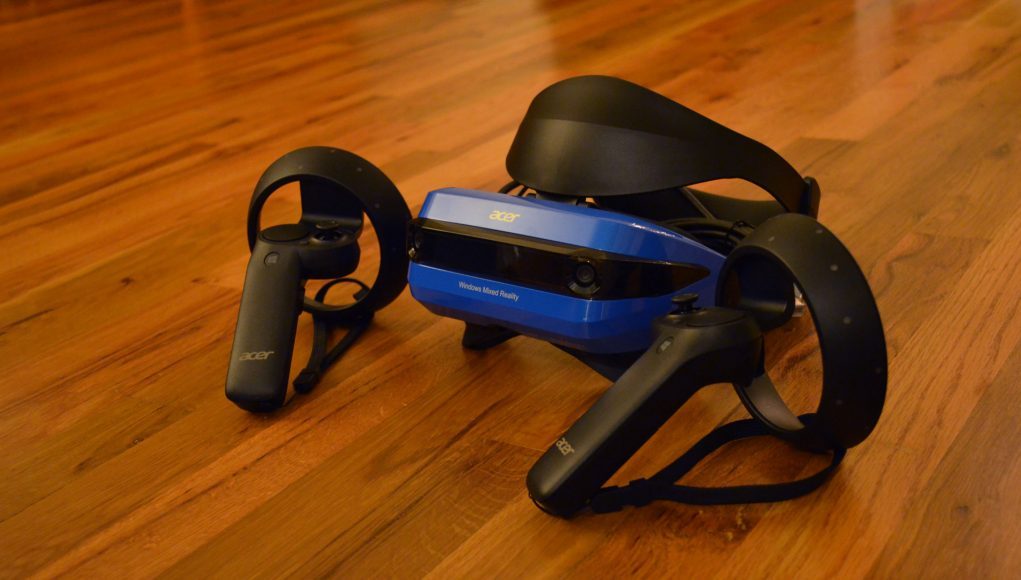Microsoft’s ‘Windows Mixed Reality’ platform has finally landed and the first batch of supported VR headsets are hitting the streets. I toured around the new Windows Fall Creators Update—which builds AR and VR support deep into the OS—with the Acer Mixed Reality Headset.
As usual, we’ll start with a general summary up top, and then expand into a deep dive further down. It’s worth noting that majority of this first batch of ‘Widows Mixed Reality’ VR headsets are built around a nearly identical lens/display/tracking camera foundation (which we understand to have stemmed from a Microsoft reference design). From that foundation, Microsoft’s partners, including Acer, have built the external look and feel of the headsets. So when it comes to specs and tracking performance, you can expect the headsets from Acer, Dell, Asus, HP, and Lenovo to be very similar.
The one major exception is Samsung’s Odyssey Windows VR headset which appears to have taken a more custom approach with unique lenses, displays, and integrated audio. Our hands-on preview of the Odyssey is here, and we expect to do a full review in time (though it doesn’t launch until early November).
Acer Windows VR Headset Review Summary
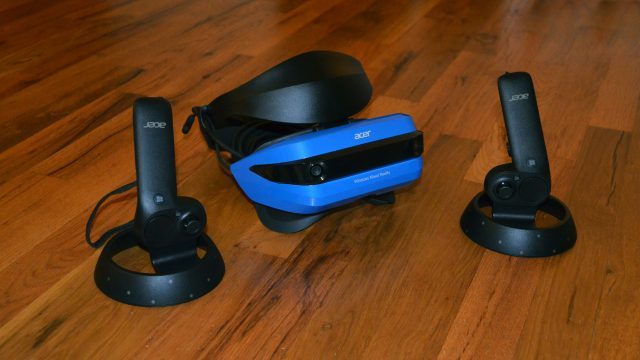
Right up front here I want to dispel any confusion that Microsoft has seeded with their non-conformist use of the term ‘Mixed Reality’. Although the Acer ‘Windows Mixed Reality’ VR headset has cameras on the front—the sort you might expect would provide pass-through video for augmented reality—actually none of these first Windows Mixed Reality headsets do any form of augmented reality, they are VR headsets through and through. The confusion comes from Microsoft using ‘Mixed Reality’ as an umbrella term to describe a spectrum of AR and VR technology. So while these VR headsets don’t support AR (which many people call mixed reality), Microsoft is saying their platform does. Now that that’s out of the way…
With the launch of a range of VR headsets and the deployment of the Fall Creators Update, Microsoft has orchestrated an impressive initial take on immersive computing and VR-enabled Windows.
With regards to Acer’s first tethered VR headset (the AH101), there’s notable pros and cons that may tilt the scale one way or the other depending upon which things you value the most. Setup is truly a breeze with native support under Windows 10 and no external sensors required for tracking. Microsoft’s inside-out head tracking is top-notch, and while the motion controllers are useable (clunky ergonomic design notwithstanding), they might not make the grade for hardcore gamers or content creators demanding the most robust hand input.
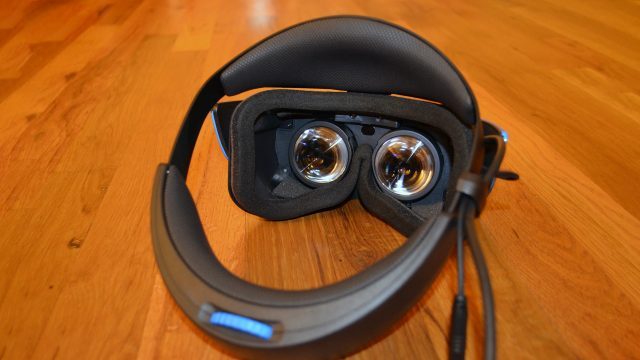
The clarity looking through the lenses is a moderate step forward with improved sharpness and a reduced (but still visible) screen door effect. The ability to flip-up the visor to interact with the real-world without removing the headset is a big plus, but there are some ergonomic annoyances (including no integrated headphones or microphone, and a design which makes it difficult to stay in the sweet spot of the lenses) that prevent the headset from being the a clear-cut winner.
All-in-all, the net result of the headset doesn’t manage to break into ‘next-gen’ territory, but instead feels like reasonable competition to what’s come before. Price is critical to the equation, especially now that the Rift’s price matches the $400 price of the Acer Windows VR headset. Looking at the headsets alone, early-adopters are likely to have a tough choice on their hands, but the Rift has the overwhelming lead on content for now (though between forthcoming Steam support and the possibility of Revive unlocking Oculus games for Windows VR headsets, things could change rather quickly).
When it comes to using the headset, the ‘Cliff House’ is the Windows VR equivalent of the desktop, a virtual space where you can place icons for immersive apps, and run traditional Windows applications as floating windows that can be placed around the environment as you desire. Having a ‘place’ to return to between diving into immersive apps, and one in which you can do traditional computing tasks (like browsing the web, downloading new apps, watching movies, etc), feels quite natural.
The space and its functions feel largely polished and stable, but the UX design is understandably clunky (and likely will be for some time, as the whole of the AR/VR industry matures the design language of immersive computing) but the foundation that Microsoft set for the future shouldn’t be underestimated. If the company can stick it out and nurture their investment while VR’s user base grows, they will have something significant on their hands.
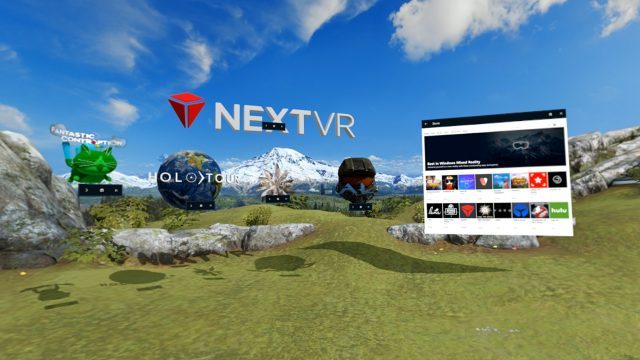
However, Microsoft has much catching up to do in the VR app department, with a mere 47 immersive apps available for their platform at the time of writing, and only three or four of VR’s most recognizable hits. Support for Steam’s VR library has been promised (and is much needed), but early adopters will need to wait until this December to get access.
– – — – –
Acer Windows VR Headset In-depth Review
Table of Contents
Note: This review is based on hardware meeting the Windows Mixed Reality ‘Ultra’ specification which has the headset’s display running at 90Hz. The Windows VR headsets can also operate on a much lower minimum specification, which runs the display at 60Hz, though we haven’t tested that mode in-depth yet. Details on ‘Ultra’ vs. minimum spec here.
PSA: All of the Windows VR headsets launching this month require a bluetooth 4.0 connection for the Windows VR Motion Controllers. Many desktop computers don’t have bluetooth built in; we picked up this bluetooth adapter [Amazon] which has worked flawlessly.
Hardware
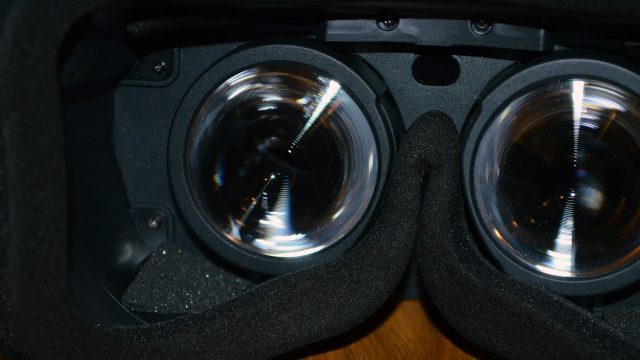
As the least expensive offering in the Windows VR headset lineup at $400 (with bundled controllers), Acer’s first VR headset packs a display with a claimed 1,440 × 1,440 per-eye resolution and ~100 degree field of view. There’s a notable increase in sharpness compared the Rift and Vive’s 1,080 × 1,200 per-eye resolution.
The ‘screen door effect’ is reduced but still visible, perhaps partly owed to the LCD display which in some ways has a more uniform screen door structure than the PenTile subpixel layout of the Rift and Vive. When combined with the excellent lack of mura (inconsistencies in color and brightness from one pixel to the next) though, the net effect is a reasonable step up in clarity, but not something many would call ‘next-gen’. LCD displays aren’t exactly typically known for fast pixel switching times, which makes it harder to make use of low-persistence to reduce ghosting; quick head movements reveal quite a bit of ghosting when combined with high-contrast scene elements, but it isn’t so bad that you’re likely to notice it much unless you’re looking for it; saccades hide this artifact quite effectively.
When it comes the lenses, we’re looking at Fresnel with medium grit ridges (between the Rift {fine} and the Vive {coarse}); expect to see god ray artifacts in high contrast scenes. The headset makes it easy to get your eyes very close to the lenses (but not so easy to keep them there, more on that below) which results in a field of view which falls well into the same class as the Rift & Vive.
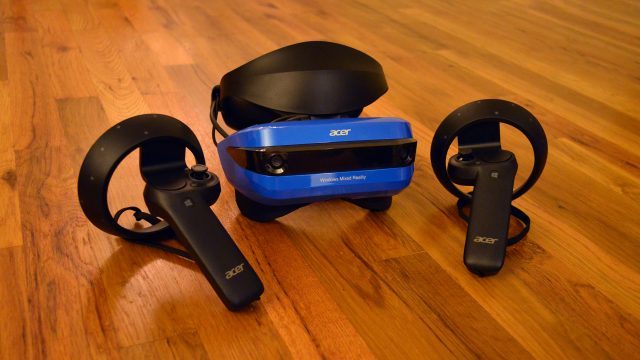
The headset’s design and materials inspire more of a practical/toy feel than a premium product. The visor feels solid enough, though the head mount that holds it in place feels somewhat flimsy at its thinnest parts. For its plastic feel though, the Acer Windows VR headset is quite light and comfortable for long-term use. It’s well-balanced and even after more than an hour of continuous use I didn’t get that usual feeling of having a brick hanging off the front of my face.
Unfortunately the particulars of the design mean it can be difficult (borderline frustrating) to keep your eyes in the small sweet spot of the lenses. It feels as if the headset’s fit was designed without consideration of the weight of the cord; its weight essentially means the headset is always off-balance to the right side, necessitating counter-tilting and tightening the headstrap more than you should need to. It seems they should have had the cord come out the center of the back strap.
The lack of integrated headphones is a shame, and feels like a step backward compared to the Rift and the Vive (with Deluxe Audio Strap). You’ll need to plug in your own 3.5mm headphones, or use a wireless pair. This is partly mitigated by the Acer VR headset’s flip-up visor which is on a hinge and can snap into an upward position, letting you easily see the real world without removing the headset. While the head mount didn’t seem to interfere with the geometry of a few different pair of overhead headphones that I tested, the tether routing point is directly over your right ear which means the cable is likely to tug and push annoyingly on larger headphones. It seems earbuds might be ideal for the Acer Windows VR headset.
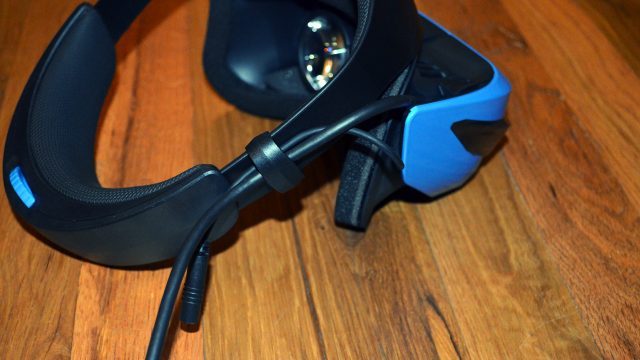
Being able to flip-up the visor is a huge plus, making it easier to find and manage your headphones, controllers, and tether, and generally reducing the pain point of needing to take off a headset and put it back on every time you need to take a quick action outside of the headset. I would be thrilled to see more headsets follow this trend.
The flip-up visor also makes putting on the headset quick and easy. I found myself starting with the visor in its flipped-up state, putting the lenses right up to my eyes, and then flipping the head mount down behind my head. This approach makes it easy to hone in on the sweet spot of the lenses right off the bat, but as I mentioned before, the headset frustratingly has trouble staying there. I found myself frequently needing to make adjustments to maintain good visual clarity.
On my face at least, the visor creates an excellent seal with no light leak whatsoever. The one downside to this is that the foam around the nose pinches my nose slightly shut, reducing the my usual air intake. It’s a feeling that is incredibly uncomfortable to me after more than a few minutes of use. I promise that, if your face is anything like mine, you will consider just cutting out that section of foam with scissors. A bit of light leak around the nose is worth the feeling of regular breathing capacity.
Controller Design & Ergonomics
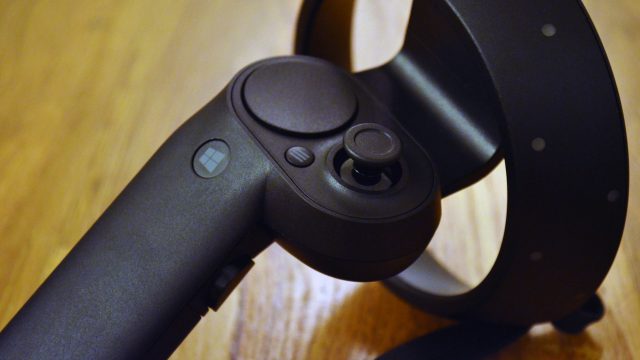
The ergonomic feel of the Windows Mixed Reality controllers makes them come off as a bit of a late addition, and leaves me waiting to go back to Touch or perhaps even the Vive controllers. They’re fairly large and unbalanced, and their big tracking rings are likely to bump into each other during moments of near-field hand interactions. The build quality feels a little cheap, especially the connection from the controller to the tracking ring, which flexes easily and doesn’t inspire much confidence in durability in the event of an accidental drop.
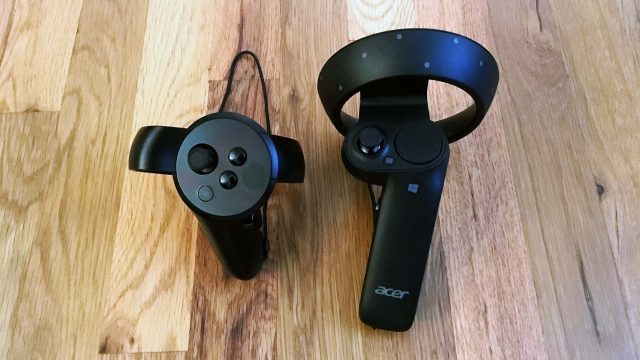
Both controllers have a trackpad and thumbstick which is an odd choice, and the placement of the pair doesn’t feel quite right for how your thumb naturally wants to rest (right between the two it turns out). The ‘grip button’ is truly a binary click-button, and feels more like an extra button than a ‘grab’. It’s quite small and can be a little awkward to press, depending upon how you’re gripping the controller (which is usually determined by whether you’re primarily using the stick or the trackpad). On the other hand, the trigger is of the squishy variety, though it isn’t clear yet if it is truly analog of not.

